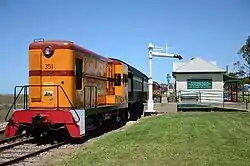South Australian Railways 350 class
The South Australian Railways 350 class comprised two diesel-electric locomotives built by the railway's Islington Railway Workshops that entered service in June 1949. They were the first diesel locomotives operated by the South Australian Railways and the first to be built by an Australian railway.
| South Australian Railways 350 class locomotive | |||||||||||||||||||||||||||||||||||||||||||||||
|---|---|---|---|---|---|---|---|---|---|---|---|---|---|---|---|---|---|---|---|---|---|---|---|---|---|---|---|---|---|---|---|---|---|---|---|---|---|---|---|---|---|---|---|---|---|---|---|
| |||||||||||||||||||||||||||||||||||||||||||||||
| |||||||||||||||||||||||||||||||||||||||||||||||
| |||||||||||||||||||||||||||||||||||||||||||||||
| |||||||||||||||||||||||||||||||||||||||||||||||
History
Locomotives number 350 and 351 spent much of their service life working in their design role as shunting locomotives – in Adelaide yard, Islington Railway Workshops, Mile End goods yard and Mount Gambier station yard. In March 1978 they were included in the transfer of South Australian Railways assets to Australian National.[1]
Both locomotives were withdrawn in 1979. Railway historical group SteamRanger bought 350 and still owns the locomotive, operating it as a depot shunter; its very low continuous tractive effort necessitates a 150-tonne load limit when it pulls a train on the Victor Harbor–Strathalbyn section of the railway.[1]

A preservation group at Moonta bought 351 for a proposed heritage railway venture that did not come to fruition. Subsequently, the Australian Railway Historical Society (now SteamRanger) bought it and restored it to operating condition at its depot, then at Dry Creek, before deploying it to Goolwa for use on the Victor Harbor Tourist Railway. After mechanical problems occurred it was placed on permanent loan to the National Railway Museum at Port Adelaide, where it remained for 25 years. In 2015 it was gifted to the Milang Historical Railway Museum. Following cosmetic restoration it is now a key element of the museum's outdoor static displays, especially since the installation of a locally developed driving simulator in the cab, which can be operated by visitors.[note 1][1]
Notes
- The museum and the driving simulator are open on Saturdays and Sundays from noon to 4pm; entry to both is free. Children under 10 need adult assistance with the simulator because of the weight and age of the locomotive's controls.
References
- "SteamRanger's diesel locos and railcars". SteamRanger Heritage Railway. Australian Railway Historical Society (SA Division) Inc. June 2019. Retrieved 3 June 2019.
South Australian Railways Diagram LD-32 https://sarplans.steam4me.net/images/SAR_Rollingstock_14.gif